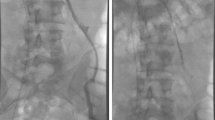Abstract
To evaluate the efficacy of transcatheter foam sclerotherapy (TCFS) in pelvic varicocele using sodium-tetradecyl-sulfate foam (STSF), we conducted a retrospective study in 38 patients (mean age, 36.9 years; range, 22–44 years) with pelvic congestion syndrome (PCS) treated between January 2000 and June 2005 by TCFS. Pelvic pain was associated with dyspareunia in 23 (60.5%) patients, urinary urgency in 9 (23.7%) patients, and worsening of pain during menstruation and at the end of a day of work in 7 (18.4%) and 38 (100%) patients, respectively. Diagnosis was made by pelvic and transvaginal color Doppler ultrasound examination, demonstrating ovarian or pelvic varices with a diameter >5 mm presenting venous reflux. TCFS was performed in all patients, using 3% STSF. Follow-up was performed by physical examination, pelvic and transvaginal Doppler ultrasound examination and by a questionnaire-based assessment of pain at 1, 3, 6, and 12 months after the procedure. Technical success was achieved in all patients (100%). In three patients a pelvic colic-like pain occurred immediately after sclerotic agent injection, disappearing spontaneously after a few minutes. No recurrent varicoceles were observed during a 12-month follow-up. A statistically significant improvement in each category of specific symptoms was observed at 1, 3, 6, and 12 months after the procedure. We conclude that TCFS of female varicocele using a 3% STSF is safe and effective for the treatment of PCS. It is associated with a significant reduction of symptoms and can be regarded as a valid alternative to other endovascular and surgical techniques.


Similar content being viewed by others
References
Venbrux AC, Lambert DL (2000) Ovarian and pelvic varices in the female patient. In: Savader SJ, Trerotola SO (eds) Venous interventional radiology with clinical perspectives. 2nd ed. Thieme Medical, New York, pp 210–216
Milburn A, Reiter C, Rhomberg A (1993) Multidisciplinary approach to chronic pelvic pain. Obstet Gynecol Clin North Am 20:643–659
Zondervan K, Yudkin P, Vessey M (2001): Chronic pelvic pain in the community–symptoms, investigations and diagnoses. Am J Obstet Gynecol 184:1149–1155
Hodgkinson CP (1953) Physiology of the ovarian veins during pregnancy. Obstet Gynecol 1:26–37
Giacchetto C, Cotroneo GB, Marincolo F, et al. (1990) Ovarian varicocele: ultrasonic and phlebographic evaluation. J Clin Ultrasound 18:551–555
Summit RI (1993) Urogynecologic cause of chronic pelvic pain. Obstet Gynecol Clin North Am 20:685–715
Giacchetto C, Catizone F, Cotroneo GB, et al. (1990) Ovarian varicocele: ultrasonic and phlebographic evaluation. J Clin Ultrasound 18:551–553
Beard RW, Kennedy RG, Gangar KF, et al. (1991) Bilateral oophorectomy and hysterectomy in the treatment of intractable pelvic pain associated with pelvic congestion syndrome. Br J Obstet Gynecol 98:988–992
Mathis B, Miller J, Lukens M (1995) Pelvic congestion syndrome: a new approach to an unusual problem. Am J Surg 61:1016–1018
Edwards RD, Robertson JR, MacLean AB, et al. (1993) Case report: pelvic pain syndrome—successful treatment of a case by ovarian vein embolization. Clin Radiol 47:429–431
Sichlau MJ, Yao JS, Vogelzang RL (1994) Transcatheter embolotherapy for the treatment of pelvic congestion syndrome. Obstet Gynecol 83:892–896
Beard RW, Highman JH, Pearce S, et al. (1984) Diagnosis of pelvic varicosities in women with chronic pelvic pain. Lancet 2:946–949
Venbrux AC, Lambert DL (1999) Embolization of the ovarian veins as a treatment for patients with chronic pelvic pain caused by pelvic venous incompetence (pelvic congestion syndrome). Curr Opin Obstet Gynecol 11:395–399
Kwohn SH, Oh JH, Ko KR, Park HC, Huh JY (2007) Transcatheter ovarian vein embolization using coils for the treatment of pelvic congestion syndrome. CardioVasc Interv Radiol 30(4):655–661
Parsonn L, Stovall TG (1993) Surgical management of chronic pelvic pain. Obst Gynecol North Am 20:765–775
Goffette P, Hammer F, Mathurin P, et al. (1995) Recurrence of varicocele after spermatic vein embolization in young patients: radiological aspect. Acta Urol Belg 63:55–56
Tarazov PG, Prozorovskij KV, Ryzhkov VK (1997) Pelvic pain syndrome caused by ovarian varices: treatment by transcatheter embolization. Acta Radiol 38:1023–1025
Capasso P, Simone C, Trotteur G, et al. (1997) Treatment of symptomatic pelvic varices by ovarian vein embolization. CardioVasc Interv Radiol 20:107–111
Cordts PR, Eclavea A, Buckley PJ, et al. (1998) Pelvic congestion syndrome: early clinical results after transcatheter ovarian vein embolization. J Vasc Surg 28:862–868
Maleaux G, Stockx L, Wilms G, et al. (2002) Ovarian vein embolization for the treatment of pelvic congestion syndrome: long term technical and clinical results. J Vasc Interv Radiol 13:171–178
Venbrux AC, Chang AH, Kim HS, et al. (2002) Pelvic congestion syndrome (pelvic venous incompetence): impact of ovarian and internal iliac vein embolotherapy on menstrual cycle and chronic pelvic pain. J Vasc Interv Radiol 13:171–178
Pieri S, Agresti P, Morucci M, et al. (2003) Percutaneous treatment of pelvic congestion syndrome. Radiol Med (Torino) 105:76–82
Bachar GN, Belenky A, Greif F, et al. (2003) Initial experience with ovarian vein embolization for the treatment of chronic pelvic pain syndrome. Isr Med Assoc J 12:843–846
Eclavea A (1998) Pelvic congestion syndrome: multicenter results. J Vasc Interv Radiol 9:184–185
Tessari L, Cavezzi A, Frullini A (2001) Preliminary experience with a new sclerosing foam in the treatment of varicose veins. Dermatol Surg 27:58–60
Author information
Authors and Affiliations
Corresponding author
Rights and permissions
About this article
Cite this article
Gandini, R., Chiocchi, M., Konda, D. et al. Transcatheter Foam Sclerotherapy of Symptomatic Female Varicocele with Sodium-Tetradecyl-Sulfate Foam. Cardiovasc Intervent Radiol 31, 778–784 (2008). https://doi.org/10.1007/s00270-007-9264-6
Received:
Revised:
Accepted:
Published:
Issue Date:
DOI: https://doi.org/10.1007/s00270-007-9264-6




